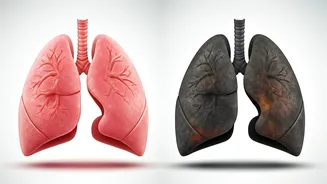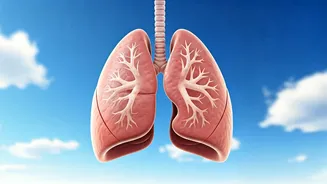Pollution's Respiratory Assault
Air pollution is a widespread environmental concern, with significant implications for human health, particularly our respiratory system. The lungs, which
are responsible for the vital exchange of gases, are constantly exposed to the external environment. This continuous exposure makes them highly vulnerable to various pollutants present in the air. These pollutants can include particulate matter (PM), such as dust and soot, which are small enough to penetrate deep into the lungs. Other pollutants such as ground-level ozone, nitrogen dioxide, and sulfur dioxide can irritate and inflame the delicate tissues of the respiratory tract. When these pollutants are inhaled, they trigger a cascade of inflammatory responses, leading to various respiratory ailments. These ailments can range from mild irritations, like coughing and throat soreness, to more severe conditions, such as bronchitis, asthma exacerbations, and even chronic obstructive pulmonary disease (COPD). The mechanisms of harm involve direct damage to lung tissues, impairment of the lungs' defense systems, and the exacerbation of existing respiratory conditions. The impact of air pollution is not only a health problem but also an environmental justice issue. It disproportionately affects vulnerable populations, especially those living in urban areas with high levels of industrial activity or traffic congestion. This underlines the importance of effective mitigation and prevention strategies to minimize exposure and protect public health.
Particulate Matter Effects
Particulate matter (PM), a complex mixture of solid particles and liquid droplets suspended in the air, constitutes a significant component of air pollution. The size of these particles plays a crucial role in determining the severity of their impact on respiratory health. PM2.5, which includes particles with a diameter of 2.5 micrometers or less, is of particular concern because it can penetrate deeply into the lungs and even enter the bloodstream. This fine particulate matter typically originates from combustion processes, such as the burning of fossil fuels in vehicles, industrial emissions, and the burning of biomass. Once PM2.5 particles are inhaled, they can trigger inflammation and oxidative stress in the lungs, leading to a variety of respiratory problems. Exposure to high concentrations of PM2.5 has been linked to increased incidence of respiratory infections, exacerbation of asthma, and the development of chronic lung diseases. The particles can also impair the lungs' natural defense mechanisms, making them more susceptible to other harmful substances and infections. Chronic exposure to PM2.5 has been associated with decreased lung function and increased mortality from respiratory and cardiovascular diseases. Therefore, monitoring and controlling PM2.5 levels are critical strategies for protecting public health, particularly in urban areas with high levels of pollution. Effective measures can include implementing stricter emission standards for vehicles and industries, promoting the use of cleaner fuels, and improving air quality monitoring systems.
Ozone and Respiratory Irritation
Ozone (O3) is a highly reactive gas that is both a natural component of the stratosphere and a pollutant at ground level. Stratospheric ozone plays a beneficial role by absorbing harmful ultraviolet radiation from the sun. However, at ground level, ozone is a major air pollutant formed through complex photochemical reactions involving nitrogen oxides (NOx) and volatile organic compounds (VOCs) in the presence of sunlight. This process typically occurs in urban areas during the warmer months, leading to ozone smog. Exposure to ground-level ozone can cause significant irritation and damage to the respiratory system. Ozone is a powerful oxidizing agent that can inflame and damage the lining of the lungs. The effects of ozone exposure can range from temporary symptoms, such as coughing, wheezing, and chest pain, to more serious health issues. People with asthma and other respiratory conditions are particularly vulnerable to ozone exposure, which can trigger asthma attacks and worsen existing respiratory symptoms. Prolonged exposure to high levels of ozone can lead to decreased lung function and an increased risk of respiratory infections. Ozone can also contribute to the development of chronic lung diseases. The health impacts of ozone underscore the importance of strategies to reduce ozone levels in urban areas. These strategies include reducing emissions of NOx and VOCs, promoting cleaner transportation options, and improving air quality monitoring to provide timely information and warnings during periods of high ozone concentrations.
Other Pollutant Impacts
Besides particulate matter and ozone, other pollutants also significantly contribute to the adverse effects of air pollution on respiratory health. Nitrogen dioxide (NO2), primarily emitted from combustion processes, such as those in vehicles and power plants, is a key component of smog and can irritate the airways, making them more susceptible to respiratory infections. Sulfur dioxide (SO2), produced mainly from the burning of sulfur-containing fuels, can also cause inflammation and constriction of the airways, leading to breathing difficulties and exacerbation of respiratory conditions. Volatile organic compounds (VOCs), emitted from various sources including industrial processes, solvents, and fuels, are precursors to ozone formation and can contribute to respiratory irritation and other health problems. The combined effects of these pollutants can be synergistic, meaning that their effects are greater when they occur together. This complex interplay of pollutants underscores the importance of a comprehensive approach to air quality management. It involves reducing emissions from a wide range of sources, implementing stricter air quality standards, and promoting public awareness of the health risks associated with air pollution. Reducing exposure to these pollutants through various methods is crucial for protecting public health. This requires a multi-faceted approach, including regulatory measures, technological advancements, and individual behavioral changes, all working towards a healthier environment.
Preventative Strategies Explored
Given the adverse effects of air pollution on respiratory health, effective preventative strategies are crucial. Reducing exposure is the primary goal, achievable through a combination of individual actions and public health measures. One of the most basic and effective individual steps is to stay informed about local air quality levels. Many cities provide real-time air quality data, enabling individuals to adjust their activities and exposure. On days with high pollution levels, it's wise to limit outdoor activities, especially for children, the elderly, and those with existing respiratory conditions. If outdoor activities are unavoidable, wearing a respirator mask, such as an N95 or higher-grade mask, can help filter out particulate matter. Enhancing indoor air quality is another important strategy. Using air purifiers with HEPA filters can effectively remove pollutants from the air, creating a cleaner indoor environment. Regularly cleaning homes to minimize dust and allergens can reduce respiratory irritants. Supporting policies that reduce air pollution is a collective responsibility. This includes advocating for cleaner transportation options, such as electric vehicles and public transit, supporting stricter emission standards for industries, and promoting sustainable urban planning. These combined individual and collective strategies can substantially reduce exposure and protect respiratory health in polluted environments.













